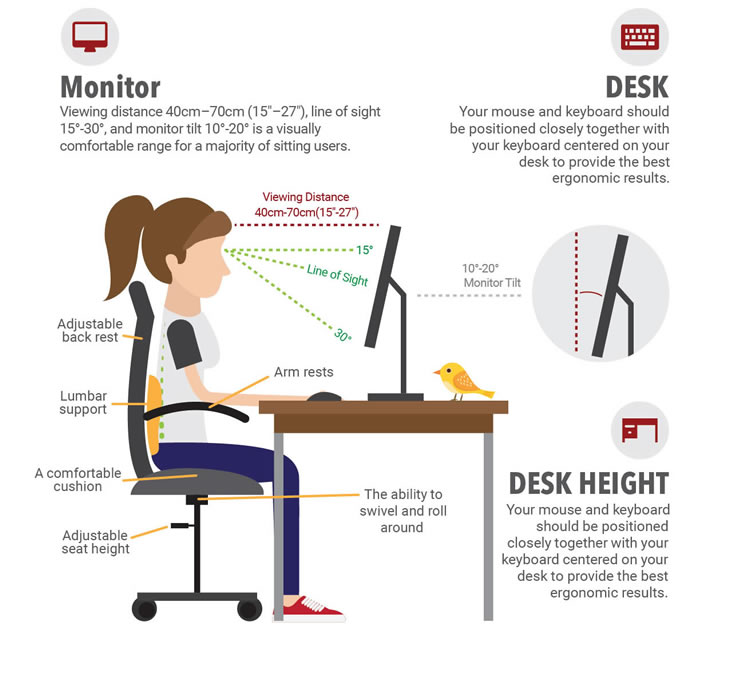With the outbreak of this global pandemic, many people were abruptly forced to work from home full-time. The lucky ones already had an ergonomic home office setup or were assisted by workplace programs. But a large part of this population is still hunching over their laptops while sitting on uncomfortable dining room chairs, sitting up in bed or slouching on couches trying to work.
Sitting in these postures for eight hours a day can have negative effects on your body leading to pain and dysfunction. Creating a work space in your home doesn’t have to be costly or stressful. By following some simple tips for setting up an ergonomic home office with the furniture you’ve already got, you can improve productivity and minimize pain.
How to Make a Dining Chair More Ergonomic
A supportive chair is essential in maintaining a healthy body in your ergonomic home office set-up. If you need to use a dining chair or your chair is not adjustable, you can help to make the chair more supportive.
- The backrest of the chair should support the natural curves of your spine. Use a rolled-up towel to provide lumbar support in your lower back, trialling out different thicknesses to see which works best for you.
- Place a towel or blanket on the seat of your chair to provide extra cushion and comfort.
- You also want to make sure your hips are slightly higher than your knees when you are sitting to maintain good alignment of your spine.
- Also, use a stool or box if your feet are not flat on the floor when your chair is in its proper set up. This will help to support and minimize strain on your lower body and low back.
- Resting your elbows and forearms on the chair or desk will also help keep your shoulders supported and relaxed.

How to Optimize Your Desk & Computer Height
The optimal desk height varies widely with a person’s height. For many working from home, changing the height of a desk or table is not an option. However, after finding the proper chair and computer height setting, blocks (use old textbooks) can be added under desk or table legs to increase the height of the desk.
- The top of the computer screen should be at eye level. This will help to minimize strain on your neck and shoulders while you are looking at your screen. Putting your laptop on a box and using a portable keyboard if possible, will help to minimize fatigue and pain.
- The computer screen should be at least an arms distance length from your eyes. Computer Vision Syndrome or Digital Eye Strain is a group of eye and vision related disorders that stem from prolonged screen use. The Canadian Association of Optometrists recommends a few tips to help reduce eye strain[i]:
- Match the brightness of your screen with your surroundings
- Minimize the reflected glare on your screen by dimming your room lights and/or using a protective screen
- Clean your screen to minimize fingerprints and dust
- Take a break every 20 minutes to look at something in the distance
While many reports have touted the benefits of standing desks, there are some precautions if you’re thinking of moving to this design. Some reports have reported standing desks as the answers to weight gain, however recent evidence suggests that standing all day at a desk only utilizes a fraction more calories (88 per hour) compared to sitting (80 calories per hour)[ii]. As well, while standing desks may help with neck and shoulder pain, it can lead to new pain in the feet or lower back. When possible having a balance between standing and sitting at your workstation is ideal.
Propel Physiotherapy offers virtual and in person ergonomic assessments to help you optimize your working environment at home. Our trained and experienced staff will examine key ergonomic risk factors to determine the root causes of any pain and dysfunction and develop recommendations and guidelines on ergonomic home office or workplace set-up, postural stretches, and exercise routine. Let us help you stay healthy and productive.
Written by









